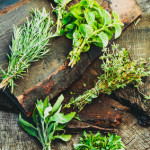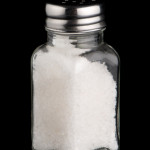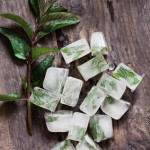Fresh herbs have delighted the senses and tantalized the taste buds for centuries. In medieval times great bundles of herbs were strewn on castle floors as a natural air purifier. Brides often chose to wear delicate crowns of flowers interwoven with herbs upon their heads, and both Western and Eastern medical practitioners may employ herbal remedies for their patients.
Many cooks are quite passionate about utilizing herbs in their favorite recipes. Especially bountiful herbs, which perfume our summer and fall gardens with beautiful scents and enhance the plate with their wonderful array of flavors. Using fresh herbs allows cooks to cut back on unnecessary salt, fat, and sugars, while naturally elevating main ingredients.
Brimming with health benefits, each herb plays a special role in beautifying and fortifying the body. Rosemary, for example, may improve memory. Parsley is packed with apigenin, which could potentially reduce the chances of cancerous growths and tumors. Oregano, like all other herbs, has anti-inflammatory properties that may reduce joint inflammation. Oregano is also particularly anti-bacterial and anti-fungal, and can contribute to flawless skin and glossy hair. The calcium content in basil and parsley can help maintain healthy teeth. Mint is calming and soothing and can be a digestive aid. The heady aroma of fresh herbs may help relieve any effects of nausea, as well as soothing and reviving the senses.
Basil’s affinity with tomatoes is a most engaging taste combination. Serve sun warmed tomatoes sprinkled with shards of fresh basil leaves and drizzled with olive oil. The slightly sharp bite of chives enlivens potatoes, eggs and salad dressings. Cilantro is a must for Mexican and Asian dishes. Dill adds a light, lovely layer to fish, while the snappy tang of parsley is delightful in tabouli, potato salad, and pasta. Mint is essential for tall glasses of cold ices tea or lemonade and also for embellishing summer fruit platters. Transport your taste buds by making a salad with a bounty of vegetables and a large handful of freshly minced oregano, basil, parsley, and dill. Or scent your grill with the woody stalks of rosemary. They make great skewers, infusing meat, fish, and vegetables with bright, strong flavors.
Clean herbs by soaking in a bowl of cool water, changing the water several times, or until you no longer see any dirt in the bottom of the bowl. Spin dry in a salad spinner or on layers of paper towels. For hot dishes, add herbs at the end of cooking time to avoid diluting their essence.
“An herb is the friend of physicians and the praise of cooks.” – Charlemagne
www.tinynewyorkkitchen.com
“Work With What You Got!”
©Tiny New York Kitchen © 2018 All Rights Reserved
Pulling a tender, juicy roast chicken with crisp, golden brown skin out of the oven is so rewarding. For a simple side, roast a pan of in-season produce like spring onions, ramps, new potatoes or carrots during the last 20 minutes of cooking.
INGREDIENTS
1 Whole Chicken (4 Pound)
1 Teaspoon Sea Salt
1/2 Teaspoon Freshly Ground Pepper
Preheat oven to 425 degrees.
Remove neck and giblets from chicken. Trim off any excess fat from neck and tail end of chicken. Rinse bird with cool running water. Pat dry with paper towels, and season all over with salt and pepper.
Place chicken, breast side up, on a rack in a small-size roasting pan or a 9×13 inch-baking dish. Tuck wings back and behind bird to hold them in place. Roast, basting once or twice with pan juices, until skin is deep golden brown and juices run clear, about 1 1/2 hours.
An instant-read thermometer inserted in the thickest part of the thigh should read 165 degrees. Let chicken rest for 15 minutes and then carve.
To add fragrant flavor, stuff the cavity with a halved lemon or orange and a handful of fresh herbs like rosemary, thyme, and oregano.
Serve with an easy salad of greens topped with cherry tomatoes, mozzarella, and a drizzle of olive oil.
Serves 4
Prep Time: 20 Minutes
Cook Time: 90 Minutes
Total Time: 110 Minutes
“Work With What You Got!”
©Tiny New York Kitchen © 2018 All Rights Reserved
Let’s face it; most of us eat way too much salt. A high-sodium diet can increase risk of high blood pressure (hypertension), which can lead to cardiovascular and kidney disease. The Dietary Guidelines for Americans recommend limiting sodium intake to less than 2,300 mg per day, which is about 1 teaspoon of salt. The good news is that reducing the amount of salt you use will retrain your taste buds to sense other flavors. You won’t even miss it.
Bland food is such a bore, but how can we keep sodium in check without sacrificing flavor?
Here are some suggestions to reduce salt in your diet:
Remove the salt shaker from the table when you eat.
Limit process foods, including cured, pickled, salted, or brined products.
Focus on fresh or frozen fruits and vegetables without sauces or seasonings.
When choosing canned options, look for “no salt added” or “low sodium.”
Cook at home so you have control over how much salt you add.
Flavored vinegar, onions, garlic, and citrus also add tons of flavor without the sodium.
Herbs and spices are the key to flavor. Add dried varieties during cooking and fresh herbs at the end of cooking or when plating a dish. Thyme, mint, lemongrass, dill, basil, oregano, chives, and parsley are great herbs to use. Spices like pepper, ginger, chili powder, and cinnamon are excellent spices to flavor your food.
“Work With What You Got!”
©Tiny New York Kitchen © 2018 All Rights Reserved
Going out for dinner on Valentine’s Day is a risky affair. Even the best restaurants can have “overload difficulties” on such a busy night where couples have expectations of restaurant perfection. A better way to manage expectations is to take control of them yourself. Food is a language of love. You know what you like and what your loved one likes. No need to worry about cheesy love songs or a perfumed soaked lady sitting next to you. Nothing says I love you more than taking the time to make a special meal for the person you love. Visit the local farmers’ market, butcher, or seafood shop to buy their favorite seasonal ingredients. Come up with a meal that celebrates love. Turn off the lights, fire up all the candles and put on your favorite music.
Keep it easy and made make it special. Plan out the meal from beginning to end to get organized and make sure you have a solid menu. If you’re not a seasoned cook make sure to keep it simple and I recommend not trying to make complicated dishes that you’ve never made before. Make it easy with three courses. Begin with a beautiful cheese plate. Embrace easy, big impact dishes. Start off with prosciutto-wrapped scallops finished with a squeeze of lemon. Warm things up with braised short ribs or steaks finished off with butter and herbs. Keep desserts simple, but sweet. Decorate bakery cakes with fresh fruit or edible flowers or warm up slices of pie and top with caramel sauce and a gourmet ice cream or try your hand at an easy dessert of chocolate pots de crème. Don’t forget that nice bottle of wine or champagne.
“Work With What You Got!”
©Tiny New York Kitchen © 2018 All Rights Reserved
Kombucha (also known as tea mushroom or Manchurian mushroom) is a fermented, slightly sparkling black or green tea beverage that is usually lightly flavored with fruit, ginger, or herbs. Kombucha is commonly intended as a functional beverage for health benefits (although there is no real scientific evidence to support health benefit claims). Kombucha is produced by fermenting tea using a symbiotic culture of bacteria and yeast. Many people, myself included, drink kombucha as a source of probiotics, which is the “good bacteria” that are beneficial for digestion. Pregnant women and children under age 4 should not drink kombucha.
“Work With What You Got!”
©Tiny New York Kitchen © 2018 All Rights Reserved
Winter Citrus Fruit is a beautiful natural ingredient that will perk up the winter table with generous juiciness and vibrant vivacious hues. Citrus fruit have a beauty that cooks can incorporate into their winter meals. As an added bonus they are an excellent snack for that nagging sweet tooth. They can bring a bit of glamor to a winter fruit salad. Arrange oranges, clementine, mandarin, pomelo or grapefruit slices and you will have a sunny rainbow of goodness for breakfast or brunch. Nothing more is needed than perhaps a scattering of fresh mint or basil. These citrus also combine well with cranberries, raspberries and strawberries, adding burst of sunshine to yogurt bowls and smoothies.
Green salads love a bit of sunshine, too. Add citrus slices to a mixture of arugula, radicchio, endive and baby kale; add minced fresh herbs, such as basil, tarragon and chill. Add a bit of creamy goat cheese and dress it all up with a vinaigrette.
The versatility of citrus makes them a superstar winter ingredient. These beautiful fruits are low in calories, have a significant amount of dietary fiber and are a nice source of folate. Rich in vitamin A and C, Citrus provides healing, soothing benefits for eyes, skin, hair, and nails and many positively impact the aging process. Consuming citrus may possibly lower the risk of heart disease, prostate cancer and macular degeneration.
Let the sunshine in!
“Work With What You Got!”
©Tiny New York Kitchen © 2018 All Rights Reserved
I like to eat seasonal fruits and vegetables. Brussels sprouts are a hearty winter vegetable and are sweetest and most tender after a hard frost. They are a good source of fiber, antioxidants, and vitamin C. Look for young, small green sprouts that have tightly formed buds. Avoid any yellowing, which means that the sprouts will be bitter, sulfurous, and tough. Use fresh sprouts within a few days after purchasing. Sprouts sold on the stalk tend to keep longer. Brussels sprouts can be boiled, braised, or steamed. Cut an X at the base of each sprout to allow for a more even cooking. Add a bit of butter, olive oil, salt, pepper, garlic, onions, or herbs of your choice. Brussels sprouts also make a nice addition to stir fry, noodles, and other dishes. As always, be creative and “work with what you got!”
“Work With What You Got!”
© Victoria Hart Glavin Tiny New York Kitchen © 2017 All Rights Reserved
One of the best ways to preserve the abundance of fresh herbs from your garden is by making flavored oils. Herb oils can be enjoyed so many ways – drizzled over salads, vegetables, pastas, sandwiches, or grilled items, hot or cold or at room temperature. Not only are they flavorful, but they also add dramatic color when drizzled on plates. If you want to add more flavor add half a clove of smashed garlic and 1/2 teaspoon crushed red pepper to the blender with the other ingredients, which makes a great dipping oil for chunks of rustic bread.
“Work With What You Got!”
© Victoria Hart Glavin Tiny New York Kitchen © 2017 All Rights Reserved
Make prep a snap with herb ice cubes, ready to toss in the pan.
Freezing herbs is an excellent way of preserving fresh delicate herbs that cannot be successfully dried. They will lose their fresh appearance and texture, but are still suitable for use in cooking. They should keep for up to 3 months.
To freeze chopped herbs, half-fill ice cube trays with chopped herbs and top up with water. Freeze, and then remove the cubes from the tray and place in freezer bags.
To use, add the appropriate number of frozen cubes to soups, stews, and stocks. Heat until melted. A standard sized ice cube tray will hold about 1 tablespoon chopped herbs.
Alternately, pack chopped herbs in plastic containers and freeze. Sprinkle them directly into soups and stews.
To freeze whole sprigs or leaves, place in freezer bags, expel any air, tightly seal and freeze.
Alternately, open freeze whole sprigs or leaves on trays. When the herbs are frozen, transfer them carefully to freezer bags, expel any air, seal tightly and return to the freezer until ready to use.
Delicate herbs that cannot be dried successfully, but that are suitable for freezing, include: basil, chives, tarragon, chervil, coriander (cilantro), dill and parsley.
“Work With What You Got!”
© Victoria Hart Glavin Tiny New York Kitchen © 2017 All Rights Reserve















